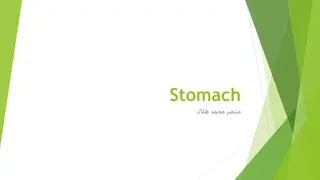Insect Abdominal Structures and Appendages: An Overview
The abdomen of insects plays crucial roles in respiration, reproduction, digestion, excretion, and metabolism. The number of abdominal segments varies across species, with reductions and modifications seen in different insect groups. From the propodeum to pregential and postgenital segments, each pa
1 views • 6 slides
Liver Transplant in India for treatment
Liver is the largest gland in our body, and an important metabolic organ which carries out many essential biological functions. The liver is a wedge-shaped, reddish-brown in color with two lobes of different size and shape. The approximate weight of a human liver is 1.5 kilograms. It is in the upper
5 views • 2 slides
Pediatric Trauma Resources: Chest, Abdomen, and Pelvis Review
This guideline provides resources for the evaluation and management of chest, abdomen, and pelvic trauma in pediatric patients. It covers a range of topics including thoracic injuries, abdominal trauma evaluation, nonoperative management protocols, and guidelines for various pediatric injuries. The
4 views • 21 slides
Blue Quaker Parrot for Sale - megabirdstores.com
Blue Quaker Parrot for Sale, also known as Monk Parakeets, are small to medium-sized parrots native to South America. Blue Quaker Parrots are predominantly blue in color, with shades ranging from light sky blue to deep cobalt. They have a compact, stocky build and a distinctive grayish face with bri
0 views • 4 slides
Comprehensive Overview of Pancreas Function and Structure
Pancreas is a vital organ in the abdomen with dual exocrine and endocrine functions. As an exocrine organ, it secretes digestive enzymes and bicarbonates into the duodenum for food breakdown. In its endocrine role, the pancreas regulates blood sugar levels by secreting insulin, glucagon, somatostati
1 views • 16 slides
Detailed Anatomy Review for GIT Blood Supply
This content provides a thorough anatomy revision focusing on the blood supply of the gastrointestinal tract (GIT). It covers stations discussing the blood supply of the stomach, complications during cholecystectomy, perforated duodenal ulcer scenarios, pancreatic tumors, and structures related to m
0 views • 15 slides
Case Review: Diagnostic Dilemma in Urology - Management Approach for a Patient with Abdominal Pain and Fever
A 58-year-old man with a history of diabetes and hypertension presents with fever and abdominal pain, raising multiple differential diagnoses including symptomatic AAA, pyelonephritis, acute appendicitis, complicated urolithiasis, or diabetic ketoacidosis. The case explores clinical manifestations,
1 views • 35 slides
Comprehensive Overview of Acute Abdomen Assessment and Management
This detailed guide covers the definition, general approach, history taking, physical examination, investigations, diagnosis, and management of acute abdomen cases. Learn about common causes, such as acute appendicitis, bowel obstruction, and medical conditions. Real-life scenarios illustrate differ
2 views • 15 slides
Understanding Choledocholithiasis: Causes, Symptoms, and Diagnosis
Choledocholithiasis, the presence of stones in the common bile duct, is a common condition found in a percentage of patients with gallstones. The stones can be primary or secondary, causing a range of clinical manifestations from silent obstruction to cholangitis or gallstone pancreatitis. Diagnosis
0 views • 40 slides
Buy Order Alidya Online - dermafillerstore.com
Buy Order Alidya Online is a specialized anti-cellulite product designed to help you achieve smoother, more toned skin. Cellulite is a common condition where the skin appears dimpled and lumpy, usually on the thighs, hips, buttocks, and abdomen.\nTex
1 views • 6 slides
Discover the Best Liposuction Doctor in Beverly Hills | Dr. Smiley
Liposuction in Beverly Hills by Dr. Smiley removes stubborn fat via advanced techniques. Ideal for areas like thighs, abdomen, and chin, it ensures minimal scarring and optimal results. Dr. Smiley's expertise in various liposuction methods, including
0 views • 3 slides
Abdominal Examination in Pregnancy: Techniques and Objectives
Examination of the abdomen in pregnancy involves assessing various aspects such as determining gestational age, measuring symphysis-fundus height, evaluating fetal lie and presentation, checking liquor amount, listening to fetal heart sounds, and monitoring fetal movements. The process includes gene
0 views • 38 slides
Anatomy and Characteristics of House Flies
Explore the intricate details of Musca (House Fly) including its scientific classification, mouth parts, aristate antenna, wings, legs, abdomen, and ovipositor. Discover unique features such as the modified labium into a proboscis, halteres aiding in orientation, sticky pads on legs for clinging, an
0 views • 11 slides
Case Study: Bladder Exstrophy in Infant - Presentation and History
Bladder exstrophy case study of a 12-day-old female infant with abnormal swelling and opening in the lower abdomen since birth. The patient's history includes antenatal, natal, and postnatal details without complications. Family-social background information is provided.
0 views • 35 slides
Understanding Ostomy: Types, Procedures, and Postoperative Nutrition Care
An ostomy is a surgical procedure done when normal bowel or bladder function is lost due to various reasons like birth defects, diseases, or injuries. It involves creating openings in the abdomen for elimination of waste. This case study highlights a patient with abdominal pain who underwent a parti
0 views • 11 slides
Understanding Occipito-Posterior Position of the Fetal Head
Occipito-posterior position of the fetal head occurs when the head is in one of the oblique diameters with the occiput directed posteriorly. It can be categorized into Right Occipito-Posterior Position (ROP) and Left Occipito-Posterior Position (LOP), affecting 13% of vertex presentations. Causes in
0 views • 32 slides
Understanding Occipito-Posterior Position of the Fetal Head
Occipito-posterior position refers to the fetal head being directed towards the back of the pelvis. This positioning can occur to the right (ROP) or left (LOP) side. It occurs in 13% of vertex presentations and may be caused by factors like pendulous abdomen, pelvic brim shape, or sacral alignment.
0 views • 31 slides
Understanding the Lymphatic System in Cattle: Nodes, Circulation, and Function
The lymphatic system in cattle plays a crucial role in maintaining overall health. It consists of lymph nodes located in various regions of the body such as the head, neck, abdomen, and hind limbs. These lymph nodes produce lymphocytes and help in filtering foreign bodies. Lymph fluid, similar to bl
0 views • 39 slides
Overview of Class Onycophora (Peripatus) Characteristics and Traits
Class Onycophora includes organisms like Peripatus, characterized by features such as possessing a thin cuticle, soft muscular body wall, scattered spiracles, cilia in genital organs, and wormlike body structure with unsegmented legs. They exhibit separate sexes, direct development, and possession o
0 views • 100 slides
Anatomy and Blood Supply of the Equine Stomach
The equine stomach is relatively small compared to the horse's body size, with distinct regions such as the cardia, fundus, body, and pyloric region. It is located on the left side of the abdomen, under the ribs. The stomach's blood supply includes branches from the aorta, splenic artery, and hepati
0 views • 23 slides
Understanding Peritoneum and Inguinal Canal in Anatomy
Peritoneum is a thin serous membrane covering the abdomen and pelvis, consisting of parietal and visceral layers with a peritoneal cavity between them. Learn about peritoneal relations, intraperitoneal versus retroperitoneal organs, and folds of peritoneum like ligaments and omenta in this detailed
0 views • 21 slides
Understanding Gastroschisis: Clinical Features, Epidemiology, and Etiology
Gastroschisis is a birth defect involving herniation of intestines outside the abdomen. This presentation covers clinical features, epidemiological aspects like prevalence rates and risk factors, along with insights into its etiology. Learn to differentiate gastroschisis from omphalocele, recognize
0 views • 14 slides
Abdominal Wall Defects: Omphalocele and Gastroschisis Overview
Abdominal wall defects such as omphalocele and gastroschisis are congenital conditions where abdominal organs protrude through an unusual opening in the abdomen. These defects result from disruptions during embryonic development, leading to serious implications for affected individuals. Different ty
1 views • 42 slides
All About Grasshoppers: Facts, Eating Habits, and Protection
Grasshoppers are fascinating insects with three body parts - head, thorax, and abdomen. They are herbivores that eat various plants and can be found in different terrains. Grasshoppers protect themselves through camouflage and other defense mechanisms. Interesting facts include their ability to hear
0 views • 6 slides
Understanding the Abdomen in Insects
The abdomen in insects is a crucial body region composed of 11 segments, each with specific functions such as bearing external genitalia and ovipositors. It is divided into pregenital, genital, and postgenital segments, with appendages specialized for reproduction. The ovipositor, essential for egg-
0 views • 17 slides
Understanding Acute Abdomen: Causes, Symptoms, and Examination
Acute abdomen refers to the sudden onset of abdominal pain, often indicating a surgical emergency. This condition can have various causes such as intestinal issues, hepatobiliary conditions, vascular problems, urological and gynecological issues, and more. Recognizing the location and characteristic
0 views • 24 slides
Understanding Pruritic Urticarial Papules and Plaques of Pregnancy (PUPPP)
Pruritic Urticarial Papules and Plaques of Pregnancy (PUPPP) is a condition that affects pregnant individuals, typically in the late third trimester or immediately postpartum. It manifests as intensely itchy raised areas of papules and plaques mainly on the abdomen, with potential spread to other bo
0 views • 11 slides
Cramps But No Periods - Sai Speciality Center
Experiencing period cramps without a period? It could be an early sign of pregnancy. Know the causes and signs of pregnancy step by step.When it comes to menstruation, some people have mild cramps and heaviness in the upper abdomen during and right b
0 views • 8 slides
Importance of Weight Training for Physical Fitness
Weight training, a fundamental method for enhancing strength and overall physical fitness, involves various exercises like isotonic, isometric, and isokinetic movements utilizing equipment such as barbells, dumbbells, and machines. Incorporating a variety of exercises targeting different muscle grou
0 views • 11 slides
Diagnostic Workup Results for Patient X
The diagnostic workup for Patient X includes various imaging studies such as ECG, CXR, Head CT scan, CT Abdomen/Pelvis, and Repeat CXR. Laboratory results show abnormal CBC values, BMP findings, LFTs, and lactate levels with associated VBG results. Further evaluation is needed based on these results
0 views • 11 slides
Radiology of the abdomen
Abdominal radiology plays a crucial role in diagnosis using modalities such as X-ray, fluoroscopy, ultrasound, CT scan, and MRI. This technology helps assess conditions like bowel obstructions, calcifications, and more. Interpreting the gas patterns, diameters, and signs seen in abdominal imaging is
0 views • 47 slides
Are Phantom Kicks Sign of Pregnancy - Sai Speciality Center
The main difference between phantom kicks and genuine kicks is that the former are sensations of movement in the abdomen that aren\u2019t coming from the baby, whereas the latter are the actual movements of the developing baby throughout pregnancy. R
1 views • 11 slides































